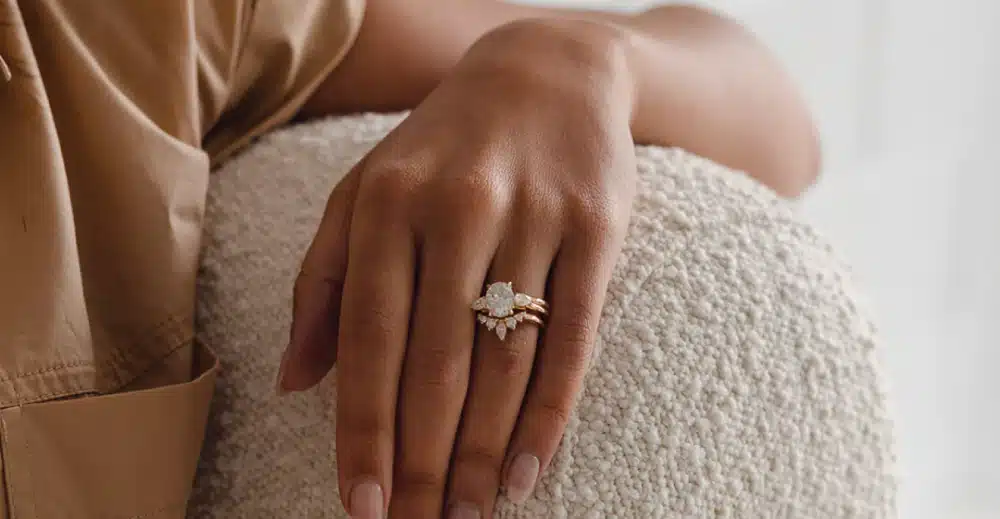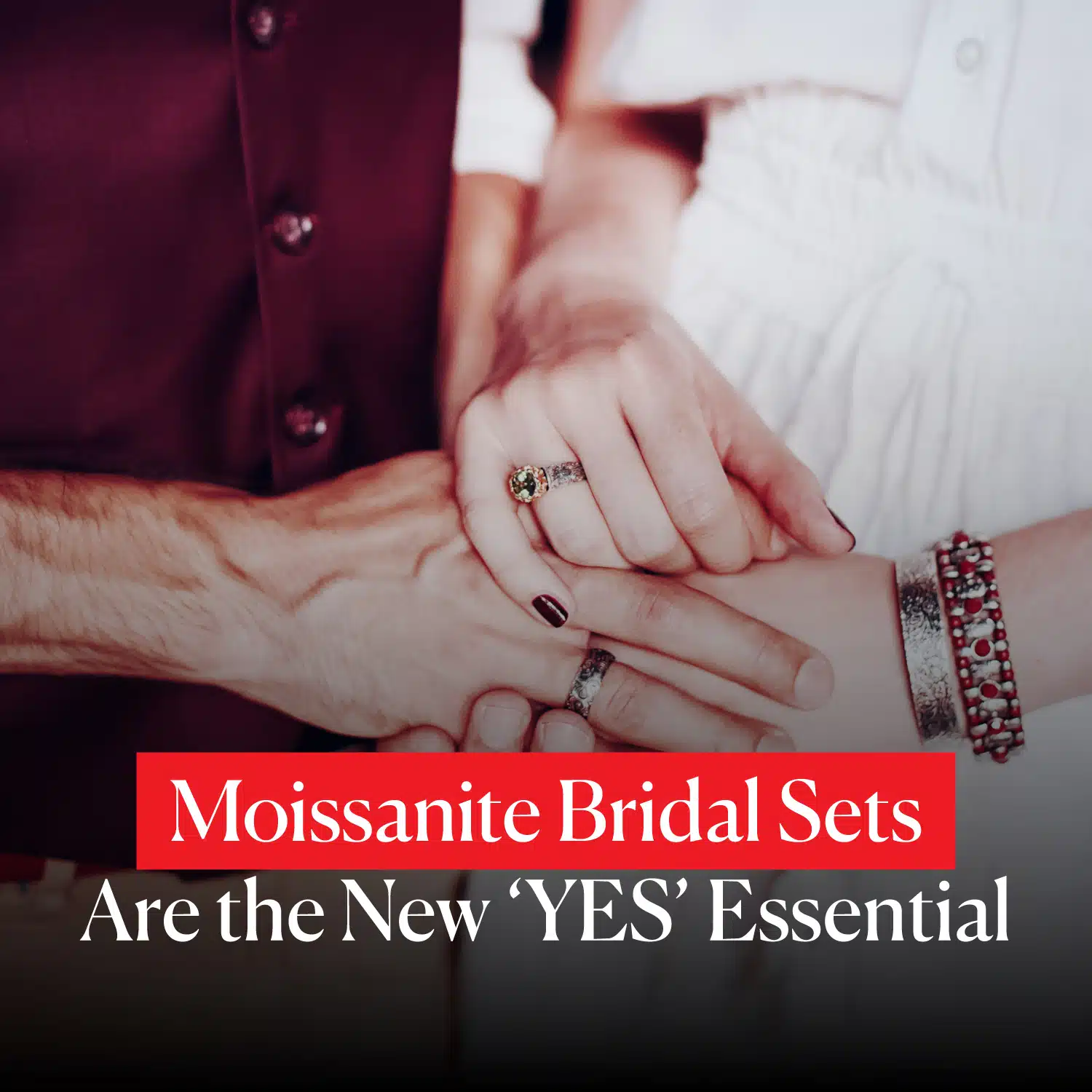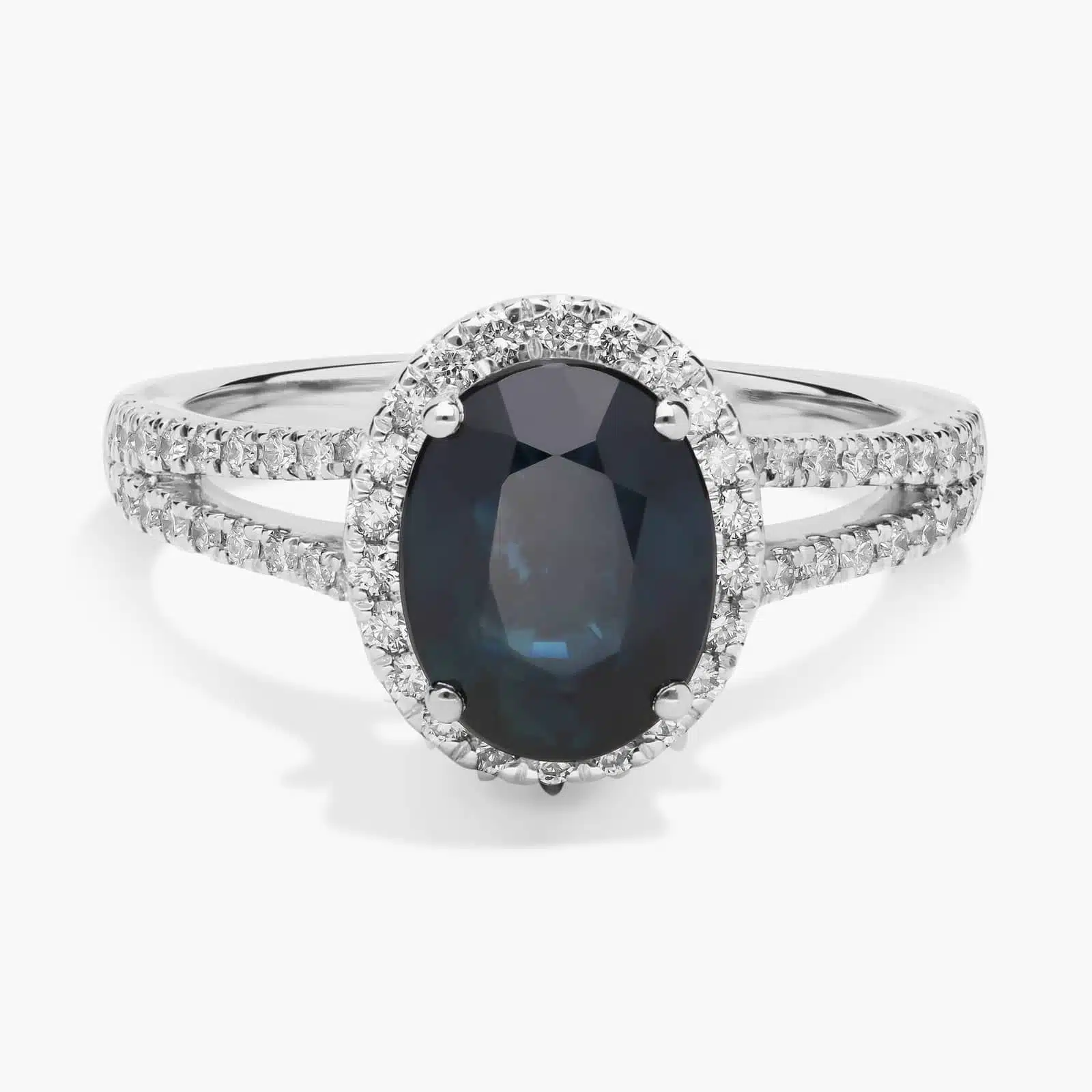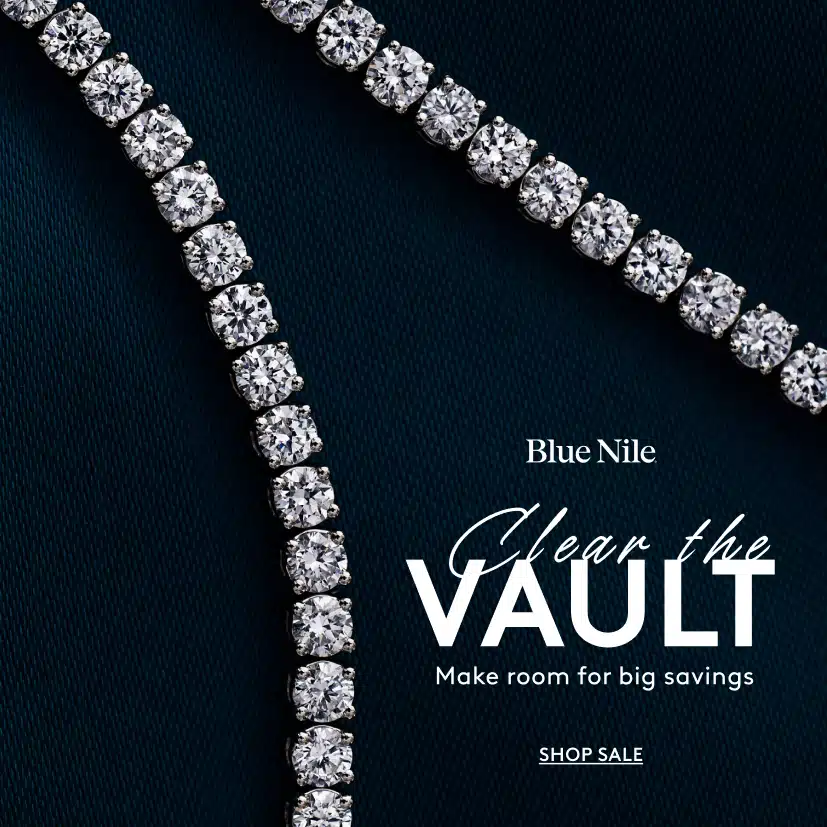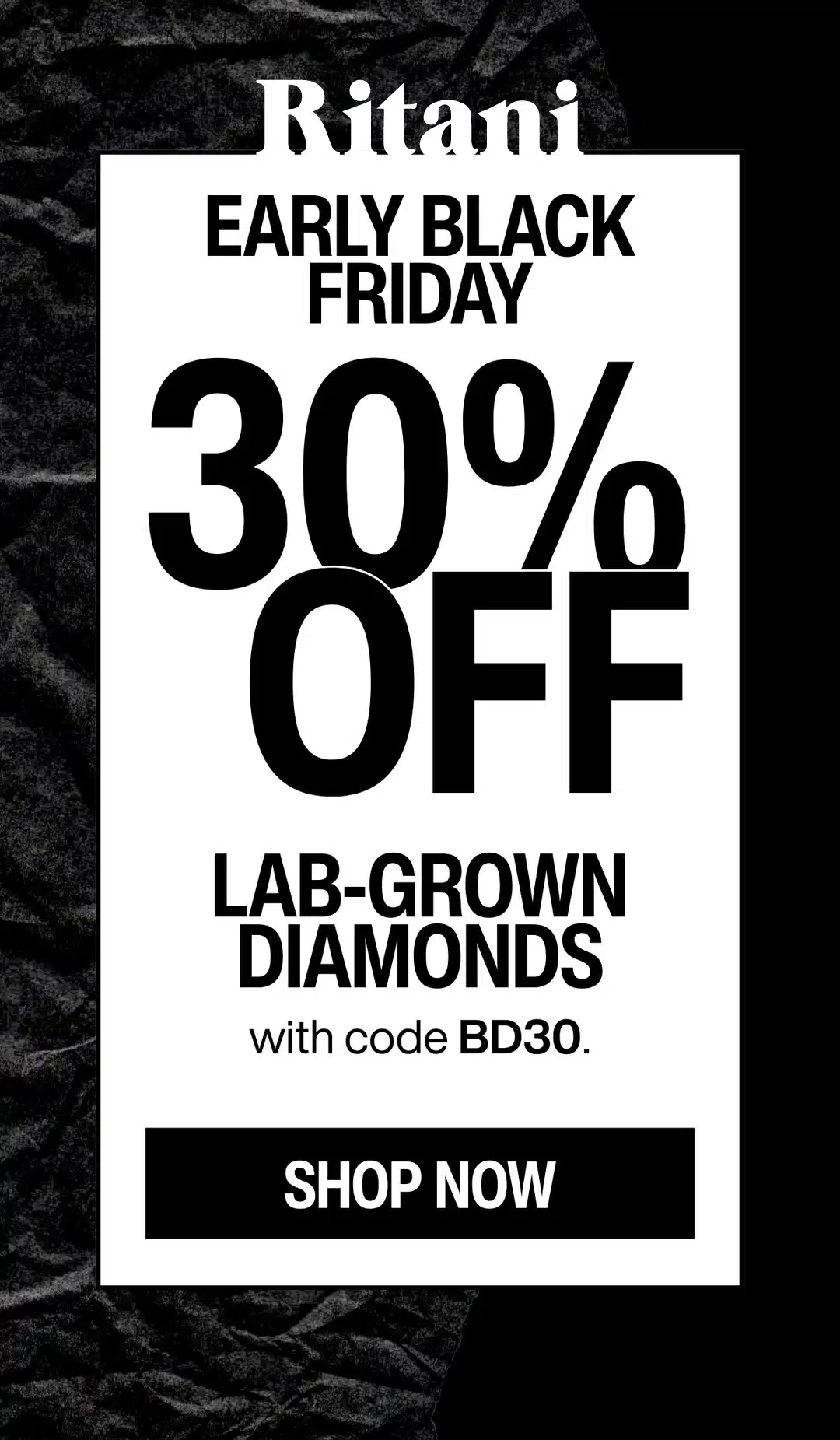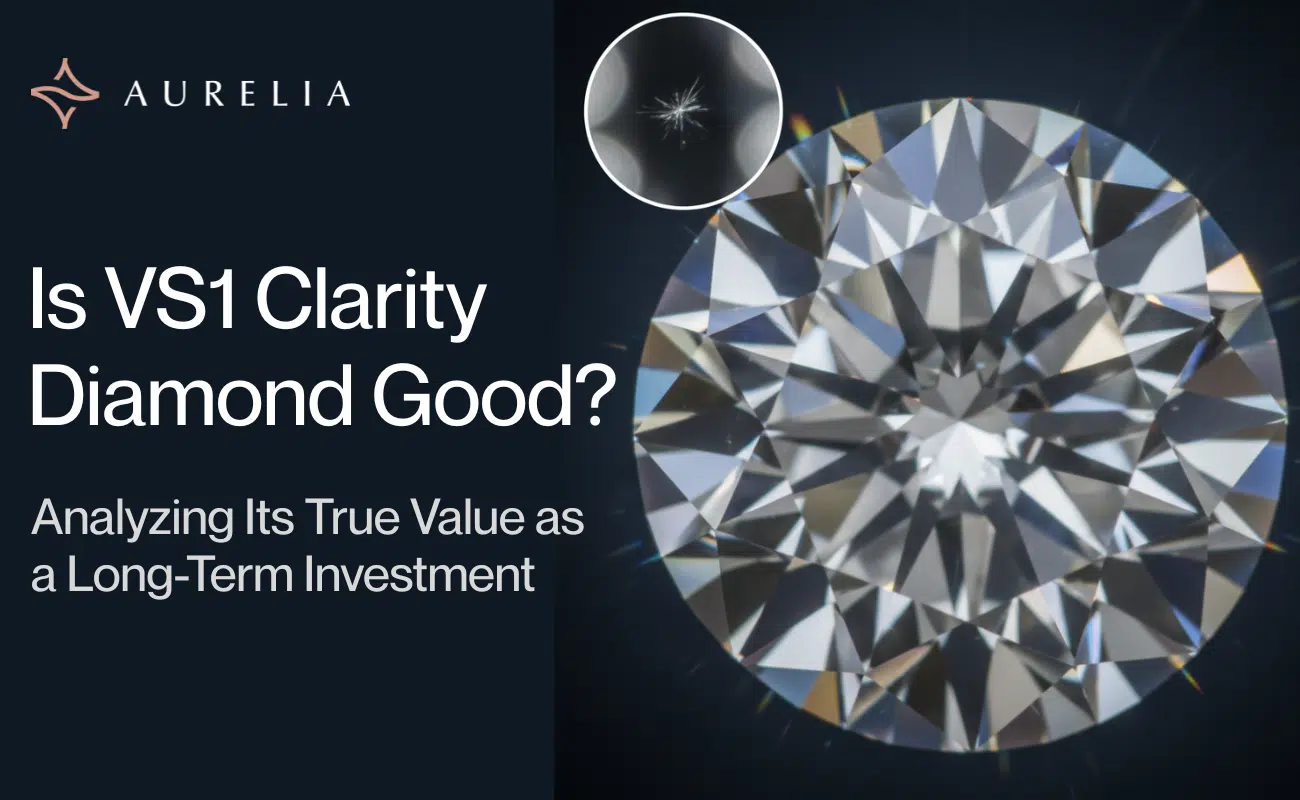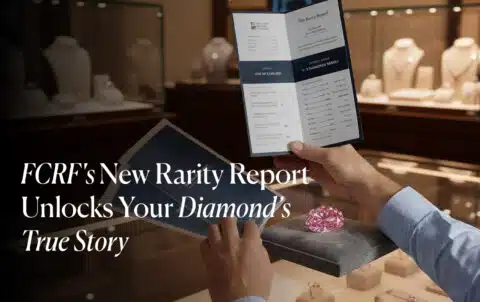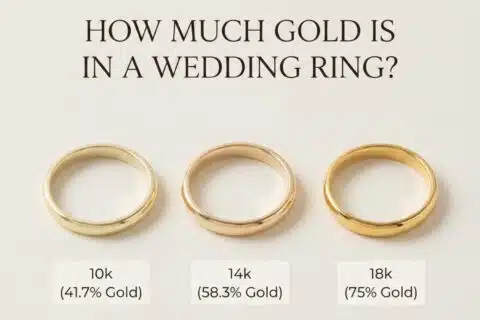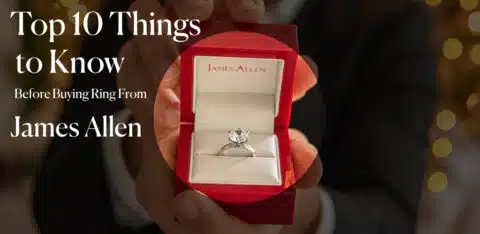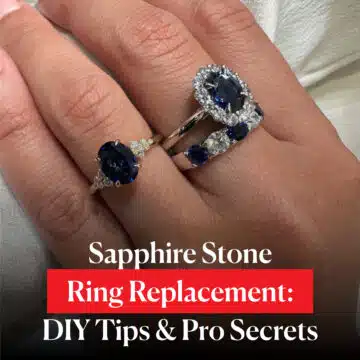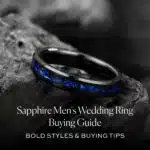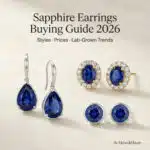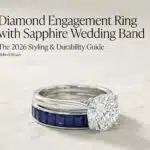Yes, a GIA-certified VS1 clarity diamond is not just good investment; it is the single smartest choice for a buyer who wants a visually flawless diamond that holds strong relative value over time.
You’re staring at two diamonds on your screen. One is a VVS1 diamond, technically near-flawless, with a price tag to match. The other is a VS1, and it costs thousands less. Your eyes dart between them, trying to spot a difference, but you can’t. You’re left with a nagging question: Is VS1 clarity good enough?
Deal Alert: Fast-Shipping Gifts — Up to 50% Off* fine jewelry at Blue Nile !
One In A Lifetime Sale: “Clear The Vault” – Get up to 70% OFF on select jewelry at Blue Nile !
Exclusive Offer: Flash Sale on James Allen Up to 40% Off * Sitewide engagement ring settings & Fine Jewelry at James Allen .
As a GIA-trained jeweler, I’m here to tell you that “good enough” is the wrong way to think about it. The VS1 is not a compromise; it is a strategic choice. It is the savvy buyer’s secret weapon, the sweet spot that delivers a visually perfect diamond without the unnecessary premium.
Today, we’re going to deconstruct this powerful grade and show you why choosing a VS1 isn’t just a good decision—it’s a winning one.
Diamond IQ Test: Natural or Lab-Grown?
Two identical diamonds: GIA Certified, 1.51ct, D Color, VVS1, Ideal Cut. One is natural ($16,530), the other is lab-grown ($2,390). Choose the diamond you like better and see if you can match it to its origin.
What Does VS1 Mean in Diamonds?
Before we get into the strategy of why the VS1 is my secret weapon, you need to understand what it is. In the sometimes intimidating world of GIA reports and diamond jargon, “VS1” is one of the most important terms you will ever learn.
So, let’s pull back the curtain and answer the core question: what does vs1 mean in diamonds, and why is this specific grade the key to getting a visually perfect ring without overspending?
The GIA’s Official Definition (And What it Feels Like in Reality)
The official vs1 meaning, as defined by the Gemological Institute of America (GIA), is “Very Slightly Included – First Degree.” But that’s just cold, clinical jeweler-speak. What does it actually feel like?
Let me give you an analogy. Imagine a brand new, perfectly clean, white carpet stretching across a brightly lit room. Now, imagine a single, tiny white feather has fallen somewhere on that carpet. If you get down on your hands and knees and you know where to look, you can probably find it after a few seconds of searching.
That single, hard-to-find feather is a VS1 inclusion. This is the very essence of the vs1 clarity meaning:
- A skilled grader, under 10x magnification, can find the very minor inclusions, but it takes them a bit of effort.
- To your naked eye, in the real world, the carpet just looks perfectly, flawlessly clean.
This reality immediately answers the question “is a vs1 diamond good?” with a resounding, confident yes. It is not just good; it is the perfect intersection of on-paper quality and real-world beauty. This level of transparency and trust is the entire reason that understanding what GIA certified means is the first step every smart buyer must take.
A diamond vs1 is a stone whose flaws are so insignificant they are essentially invisible in the real world.
The Official VS1 Clarity Chart: Finding the Sweet Spot
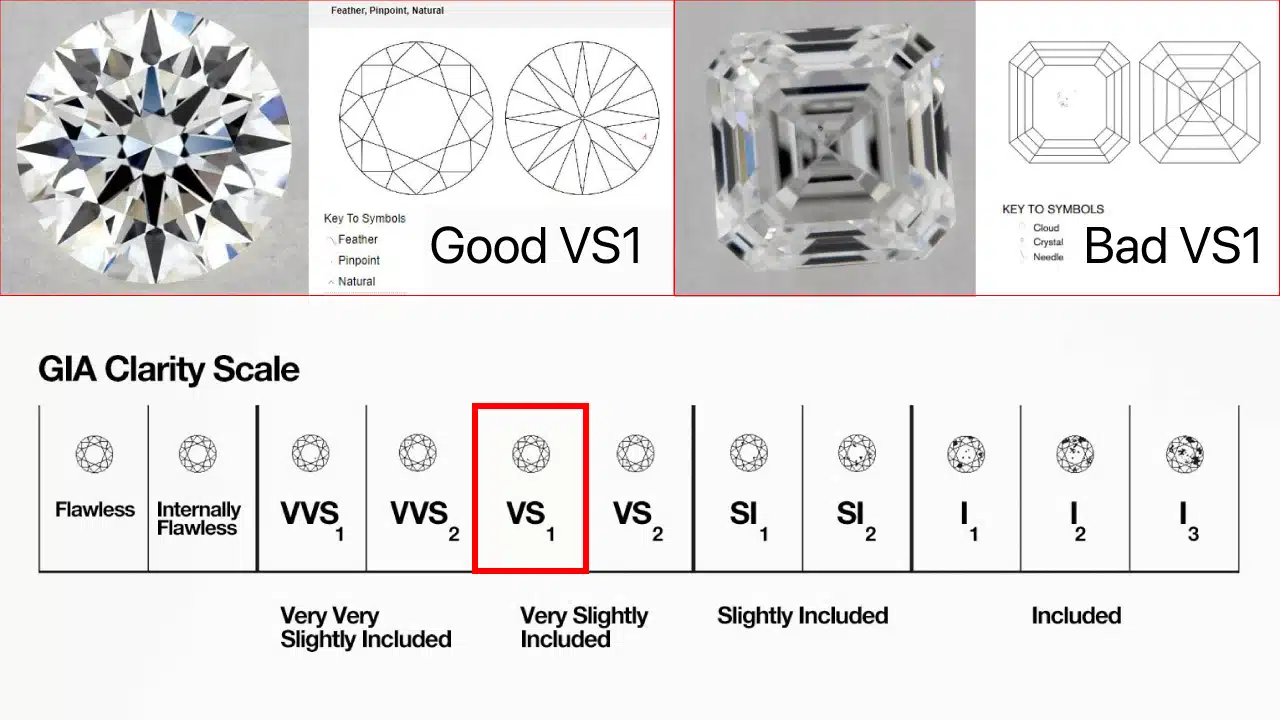
To truly understand why the VS1 diamond is so special, you have to see where it lives. It doesn’t exist in a vacuum; it sits on a map of rarity and value that governs the entire diamond market. I like to think of this vs1 clarity chart not as a list, but as a series of different “neighborhoods.”
| Clarity Tier | GIA Grade | Mehedi’s Take |
| Flawless Tier | FL / IF | The Collector’s Grade. The pinnacle of rarity. |
| VVS Tier | VVS1 / VVS2 | The “Near-Flawless” Grades. Technically magnificent. |
| VS Tier | VS1 / VS2 | The Smart Buyer’s “Sweet Spot.” Visually perfect. |
| SI Tier | SI1 / SI2 | The Value Hunter’s Grade. Can be “eye-clean.” |
This chart is the key to understanding what is vs1 clarity in the context of the entire market.
- The Flawless & VVS Tiers: Think of these as the luxury penthouses. They are magnificent, technically perfect, and carry a massive price tag for that on-paper perfection. My guides to VVS1 and VVS2 diamonds explore these grades in detail.
- The SI Tier: This is the value hunter’s neighborhood. You can find some incredible, eye-clean deals here, especially in an SI1 clarity diamond, but it requires a very careful inspection.
And then there’s the VS Tier.
This is the sweet spot. The VS (Very Slightly Included) neighborhood, and VS1 specifically, is the perfect intersection of guaranteed “eye-clean” beauty and intelligent, real-world value. The entire VS1 grade, the very essence of what are vs1 diamonds, exists for the savvy buyer who wants a visually flawless diamond without paying the unnecessary premium for the “near-flawless” VVS grades.
It is the top grade in the sweet spot tier, making it the safest bet for guaranteed visual perfection. This is why when someone asks me “which diamond clarity is best?“, my answer almost always starts with VS1.
The $5,000 Question: VVS2 vs. VS1 vs. VS2
Alright, this is where we get to the heart of it. This is where the grades on a piece of paper collide with the hard reality of your bank account. You’re in the final stretch, staring at three diamonds on your screen. To your eye, they all look perfect. But their price tags tell three very different stories.
This is the triple-threat showdown: the ultimate battle between VVS2, VS1, and VS2. It’s the championship match for “eye-clean” diamonds, and I’m going to give you a ringside seat to the action.
The Only Concept That Matters: The Holy Grail of “Eye-Clean”
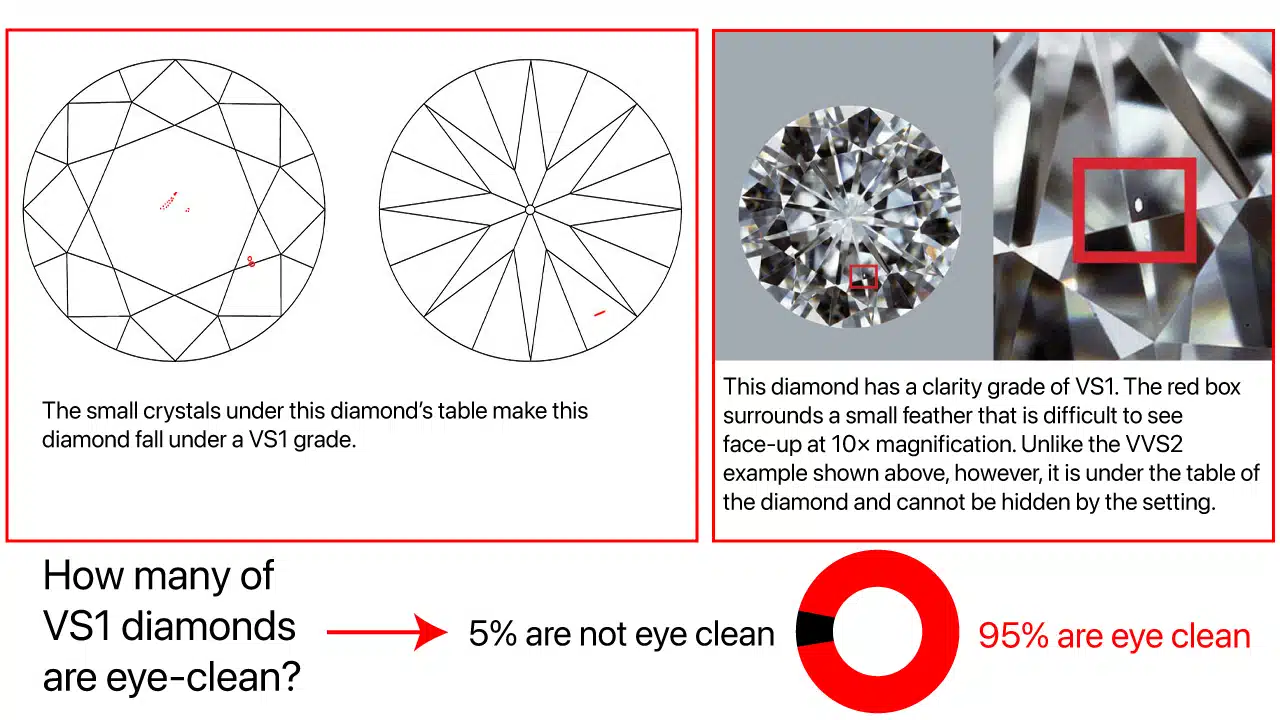
Before we look at a single diamond, let me tell you my #1, unbreakable, golden rule for diamond clarity: your goal is not to buy a flawless diamond; your goal is to buy a diamond that is “eye-clean.”
An “eye-clean” diamond is a stone with absolutely no inclusions or flaws that are visible to the average person’s naked eye from a normal viewing distance (about 6-10 inches away). That’s it. That’s the holy grail.
You don’t get extra points or a more beautiful ring for paying a massive premium for a level of microscopic purity that only a GIA gemologist with a 10x loupe can appreciate.
And here is the absolute, most important secret I can share with you today: a GIA-certified VVS2, a well-chosen VS1 diamond, and a great VS2 are all 100% eye-clean.
So, the whole debate of “is vvs2 better than vs1?” is a trick question. Visually, from your perspective, they are equals. The real question is: “What are you willing to pay for an invisible, on-paper difference?” For a complete masterclass on this value-hunting strategy, my definitive guide, What Is The Best Diamond Clarity?, is a must-read.
A Head-to-Head Comparison: The Jeweler’s Scorecard
To make this simple, let’s put these three grades on a scorecard. This is how a professional jeweler thinks about these grades when it comes to both their on-paper technicals and their real-world, financial impact.
| Grade | On the GIA Report | To Your Naked Eye | For Your Wallet |
| VVS2 | A technical masterpiece. | Looks completely, perfectly clean. | The “Peace of Mind” premium. |
| VS1 | Very minor, tiny inclusions. | Looks completely, perfectly clean. | The no-doubt “Sweet Spot” value. |
| VS2 | Minor, small inclusions. | Looks completely, perfectly clean. | The savvy buyer’s value champion. |
A Real-World Price Test: The $4,500 Difference You Cannot See
Let’s make this brutally, tangibly real. We’re going to go shopping right now on Blue Nile and James Allen. Our mission is to build a classic, significant engagement ring with a 1.50 carat, H-color, Excellent Cut Round Diamond. The only thing we’ll change is the clarity.
First, let’s find our VVS2.
- We’re on Blue Nile, and we find a stunning 1.50 Carat, H-Color, VVS2-Clarity Diamond. I pull up the 360° video. I zoom in as far as the technology will allow. The stone is a pristine, brilliant sheet of ice. It is magnificent. You feel the peace of mind of its “near-flawless” status.
- The Price: $11,500. For this on-paper perfection, this is your benchmark.
Read Our 5-Star Blue Nile Review
Check our comprehensive Blue Nile review to learn why we rated Blue Nile 5 stars for their exceptional quality and value.
Now, let’s start the hunt for value. Let’s see what stepping down one tier to the champion of the “sweet spot” looks like.
- On the same site, we find a beautiful 1.50 Carat, H-Color, VS1-Clarity Diamond. I pull up its 360° video. I zoom in. I spin it around. I specifically hunt for the tiny VS1 inclusion noted on its GIA report. It’s an invisible pinpoint feather near the outer edge of the stone. To my naked eye—and to yours—it is perfectly identical to the VVS2.
- The Price: 10,200. Just by making one smart, visually-based decision, you have just saved 1,300.
Best Deal Of The Year – Final Days
Blue Nile’s “Clear The Vault” is ON.
Shop Fine Jewelry Upto 70% OFF.
*Exclusions may apply. See Blue Nile for complete details.
But why stop there? Let’s go for the ultimate value play.
- We jump over to James Allen to use their legendary “SuperZoom” technology. We find a gorgeous 1.52 Carat, H-Color, VS2-Clarity Diamond. Note: it’s a tiny bit bigger! This is the value hunt in action. I fire up their best-in-class zoom.
I use the GIA report’s plot map to locate the VS2 inclusion—a small, transparent crystal cloud off to the side, completely camouflaged by the diamond’s brilliance. To your eye, it is, once again, flawlessly, perfectly identical to the VVS2 and the VS1. - The Price: $7,000.
Let’s pause and feel the weight of that. That is not a typo. By making an informed, confident decision based on what your eyes can actually see, you have just found a visually identical (and slightly larger!) diamond and saved an incredible $4,500.
This is the power of savvy shopping. The difference between vs1 and vs2 (and vvs2) is a difference measured in thousands of dollars, all for an on-paper detail your dinner guests and even your own eyes will never, ever see. It proves that for a brilliant-cut like a Round Brilliant Diamond, the smart buy is almost always the VS1 or a well-chosen VS2.
The Secret Ingredient: How a Great Cut Makes Your VS1 Look Flawless
Alright, we’ve established that a VS1 is the smart financial choice. But now, I’m going to share the secret that unlocks its true power. This is the single most important piece of advice I can give you, a truth that separates the amateurs from the pros and ensures your ring is breathtakingly brilliant.
There’s a hidden ‘C’ that matters more than all the others, and it is the absolute best friend your VS1 diamond will ever have.
Cut is the Engine of Sparkle, Not Clarity
Let me be as blunt and as clear as I possibly can be: a diamond’s sparkle and brilliance come almost entirely from its Cut quality, not its clarity grade.
This is a truth that many jewelers don’t emphasize enough. People get so obsessed with the “purity” of a VVS1 that they completely miss the point. A diamond is not a museum piece to be studied under a microscope; it’s a dynamic gem meant to be a supernova of light on your finger. And that fire, that life, that brilliance—it’s all born from the precision of its facets.
I’ll put it this way: I would, 100 times out of 100, choose a GIA Excellent Cut VS1 diamond over a GIA “Good” Cut VVS1 diamond.
- The VS1 diamond with the Excellent cut will be a breathtaking, fiery, head-turner.
- The VVS1 diamond with the Good cut will be a dull, lifeless, glassy-looking stone. It is a “dud.”
One is a visual masterpiece; the other is just a list of expensive stats on a piece of paper. This exact scenario was perfectly captured by a Reddit industry pro, StockAdhesiveness351, who watched a client choose an inferior stone because of its specs:
I worked with a client that wanted to keep his online F color VVS1 diamond even though the G color VS2 diamond I had looked WAY better. He, like many, believe the paper matters more than the actual diamond in front of him. I question why someone would pay for filet mignon and be satisfied with the pizza they’ve been given.
He is absolutely right. The cut is the filet mignon. A VVS1 grade on a poorly cut diamond is just expensive pepperoni on a mediocre pizza.
The vs1 diamond quality is fully realized only when its cut is top-tier. To truly become a master of this concept, my guide to the Diamond Cut Chart is your bible.
How a Blizzard of Sparkle Hides Inclusions
So, how does this directly impact your choice of a VS1? This is where the magic happens. An “Excellent” or “Ideal” cut is your VS1’s secret weapon, its ultimate camouflage.
Think of it like this: a perfectly cut diamond is a blizzard of sparkle. It’s a chaotic, beautiful storm of light, with fire (rainbow flashes) and brilliance (white light) bouncing around internally and exploding back to your eye.
The tiny, microscopic inclusions inside a VS1—that little feather, that pinpoint crystal—are completely and utterly overwhelmed by this blizzard of light.
- The Light Overwhelms the Flaw: Your eye is so busy being dazzled by the intense sparkle that it simply cannot focus on the tiny inclusion hidden within.
- It’s the Ultimate Insurance Policy: A top-tier cut grade is your ironclad guarantee that your VS1 diamond will be visually perfect. The brilliance itself is what makes it “eye-clean.”
This is especially true for shapes that are specifically designed to maximize fire and brilliance, like the spectacular Radiant Cut Diamond. A well-cut Radiant with a VS1 clarity is one of the smartest buys in the entire diamond world, as its crushed-ice faceting is a master at hiding imperfections.
Imagine you’re on James Allen, looking at a 1.80 Carat G-VS1 Round Brilliant. When you spin the 360° video and see that explosive sparkle, you’re not just seeing a pretty diamond. You are seeing the very reason you don’t need to spend thousands more on a VVS1. The cut is doing its job, and it’s doing it beautifully.
The bottom line is this: a great cut doesn’t just make your diamond beautiful; it makes it a smarter investment. It is the secret ingredient that unlocks the incredible value of the VS1 diamond.
The Savvy Buyer’s Secret Weapon: Using Fluorescence to Your Advantage
Alright, you’ve mastered the concept of VS1 as the value “sweet spot.” You know that a superior Cut is the secret to making it look flawless. Now, I’m going to share a final, jeweler-level hack. This is the one that the old-school diamond trade almost doesn’t want you to know about.
What if I told you there was a specific characteristic listed on a GIA report that could actually make your diamond look whiter and save you an additional 10-15% at the same time?
It sounds too good to be true, I know. But it’s real. And it’s called Fluorescence.
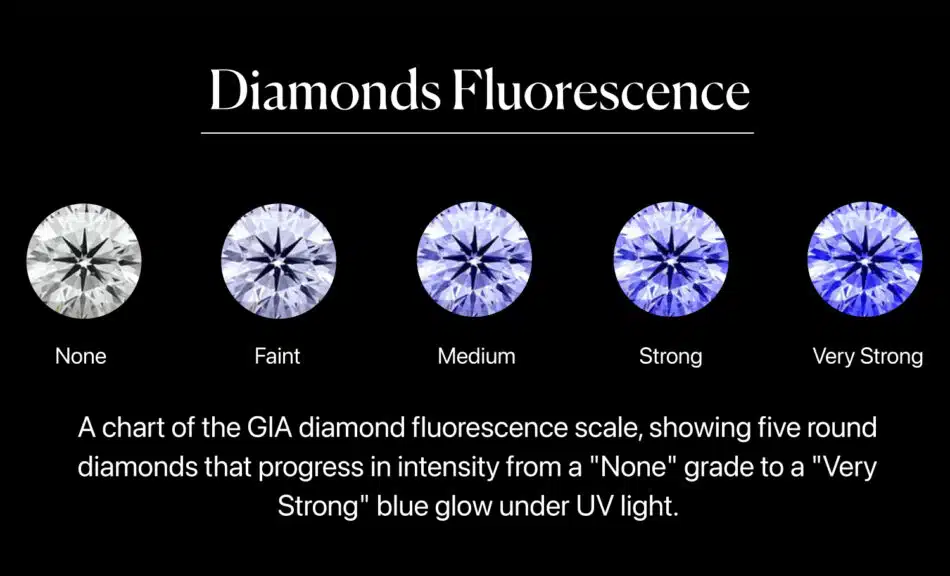
The Myth of “Bad” Fluorescence (And Where the Truth Lies)
For decades, fluorescence has gotten a bad rap in the diamond world. It’s a natural phenomenon where a diamond emits a soft glow (usually blue) when exposed to ultraviolet (UV) light, like from the sun. In a very small percentage of cases (less than 2%), a “Strong Blue” fluorescence can cause a high-color diamond to appear slightly hazy or milky.
Because of this rare possibility, the entire market has developed a bias against any fluorescence, creating one of the most significant and irrational pricing inefficiencies you can exploit.
The truth, as I explain in my definitive Diamond Fluorescence: Flaw or Feature? guide, is this: for the vast majority of diamonds, “Faint Blue” or “Medium Blue” fluorescence is completely invisible and has absolutely zero negative effect on the diamond’s appearance. In fact, for a smart buyer, it can be a massive advantage.
The Whitening Effect and the Price Discount: Your “Two-for-One” Win
Here’s how you turn this outdated market bias into your secret weapon. This is the ultimate “two-for-one” win for a savvy diamond hunter.
Let’s talk simple color science. When you’re buying a diamond in the “Near Colorless” range—like a G, H, or the fantastic value I color—there is a trace amount of yellow body color in the stone. Blue is the direct, complementary color to yellow.
When a diamond with “Medium Blue” fluorescence is viewed in daylight (which contains UV light), the blue glow is activated. This blue directly counteracts the faint yellow in the diamond, making it appear a full color grade, and sometimes even two grades, whiter than its GIA report suggests.
- An h color vs1 diamond with Faint Blue fluorescence can “face-up” looking like a more expensive G-color stone.
- An I-color stone can look like an H.
Imagine you’re on Blue Nile looking at a beautiful 1.75 Carat, H-Color, VS1 Diamond with Faint Blue Fluorescence. When you take that diamond out into the sun, it’s going to look just as icy-white as a much more expensive G-color diamond with no fluorescence.
Here’s the best part. Because the market still unfairly discounts stones with any fluorescence, that same diamond with “Medium Blue” fluorescence will often be 10-15% cheaper than an identical diamond with “None” for fluorescence.
You are paying less money for a feature that is actively making your diamond look better. It is the single greatest market inefficiency that a savvy buyer can exploit.
The Bottom Line: Your New Pro-Level Strategy
For a vs1 natural diamond, this is the ultimate pro move. If you are shopping in that G, H, or I color range, you should actively seek out a GIA-certified stone with “Medium Blue” fluorescence. You will get a visually stunning stone that punches well above its weight class in color, and you will pay a significant discount for the privilege.
It is, without a doubt, one of the smartest, most satisfying ways to get an absolutely spectacular diamond for your money.
What a VS1 Diamond Should Cost: Natural vs. Lab
So, we’ve established that the VS1 diamond clarity is the undisputed “sweet spot” for getting a visually flawless look. But what should you actually expect to pay for this savvy choice?
This is where the entire diamond market splits into two completely different universes: the world of natural, earth-created diamonds and the world of modern, lab-grown diamonds.
Understanding the colossal price difference between these two is the final key to unlocking the perfect ring for your budget. Let’s break down the numbers.
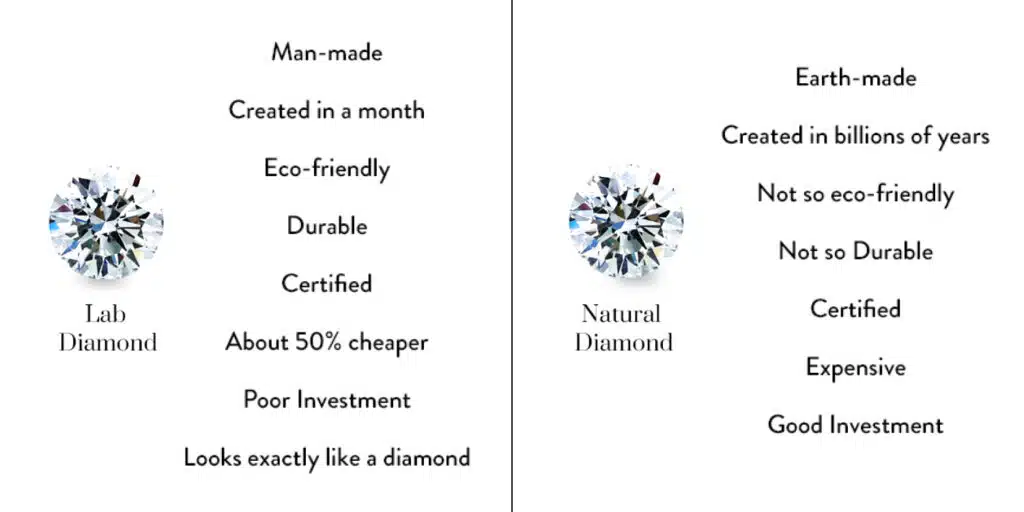
The Cost of a VS1 Natural Diamond: The Price of Rarity
When you’re looking at a vs1 natural diamond, the price is driven by one primary factor: rarity. Finding a beautiful, eye-clean crystal of a significant size that was formed over a billion years in the earth’s mantle is an incredible feat of geology.
As the carat weight increases, that rarity becomes exponentially more significant, and the price climbs a very steep pyramid.
Here’s what that pyramid looks like in the real world.
Natural GIA VS1 Diamond Price (Approximate – G Color, Excellent Cut)
| Carat Weight | vs1 diamond price per carat (approx.) | Example Total Price |
| 1.0 Carat | ~$6,000 | ~$6,000 |
| 2.0 Carat | ~$10,000 | ~$20,000 |
| 3.0 Carat | ~$15,000 | ~$45,000+ |
As you can see, the price of a diamond vs1 doesn’t just double when you double the size; it can triple or even quadruple. That 2 carat vs1 diamond price is where you enter into serious “luxury car” territory. You are paying for the magic and the legacy of a natural stone.
And for a truly magnificent piece, like the kind of 4 carat solitaire diamond ring that turns heads from across the room, the investment is immense.
The Cost of a VS1 Lab Grown Diamond: The Power of Accessibility
Now, prepare for a completely different reality. A vs1 lab grown diamond is a masterpiece of human ingenuity, not a miracle of geological luck. The ability to create these stunning, visually perfect diamonds with precision and consistency fundamentally shatters the old pricing model based on rarity.
This is where the steep pyramid of natural diamond pricing collapses into a gentle, sloping hill of accessibility. This is where the “sweet spot” becomes a truly unbelievable deal.
Here’s what that looks like on a price chart for a vs1 lab grown diamond.
Lab-Grown GIA/IGI VS1 Diamond Price (Approximate – Round Brilliant)
| Carat Weight | Price (G Color) | Price (D Color) |
| 1.0 Carat | ~$1,000 | ~$1,300 |
| 2.0 Carat | ~$2,800 | ~$3,500 |
| 3.0 Carat | ~$5,500 | ~$6,500 |
Let these numbers sink in for a moment. This is the unspoken truth of the modern diamond market laid bare. A savvy shopper on Reddit put it perfectly when they realized why paying a premium for a VVS was pointless, saying,
Splurging for VVS isn’t a flex, it means you spent money on something that isn’t discernible or apparent to anyone who looks at your diamond.
This is the exact principle that makes the vs1 lab diamonds such an incredible victory for the consumer.
- You can get a spectacular 2 carat vs1 diamond—a true showstopper—for less than half the price of a smaller 1 carat natural diamond.
- The premium for on-paper perfection is tiny. The price jump to get a flawless, icy-white d vs1 diamond or a stunning e vs1 diamond is often just a few hundred dollars—an accessible luxury rather than a massive financial leap.
Think about it this way. For the cost of a beautiful 1.5 carat natural G/VS1 diamond, you could instead go to James Allen and build a breathtaking James Allen 4-Carat Diamond Ring with an F-Color, VS1 lab-grown diamond and still have thousands of dollars left over.
The bottom line is this: a vs1 clarity lab grown diamond isn’t just a “good value.” It is a revolutionary choice that allows you to get a bigger, brighter, and visually perfect ring for a fraction of the cost.
It’s the ultimate smart money move, a strategy made possible by the incredible selection at the best places to buy engagement rings online.
When a VS1 is Not a Guaranteed Slam Dunk
Okay, for the past ten minutes, I’ve been singing the praises of the VS1 grade. I’ve called it the “sweet spot,” the “smart money move,” and the “secret weapon.” And for 90% of the diamonds you will look at, that is the absolute truth.
But an expert’s job isn’t just to give you the rules; it’s to teach you the exceptions. And there are three specific scenarios where a VS1 diamond clarity grade is not a guaranteed slam dunk, and where you, as a newly empowered and savvy buyer, need to bring an extra level of scrutiny to your search.
This is the advanced class. Let’s dive in.
The Shape Dilemma: Why Step-Cuts Change the Rules
This is the most important exception. The reason a VS1 works so beautifully in a Round Brilliant Cut Diamond or a fiery Cushion Cut is because their “brilliant” faceting style is a chaotic blizzard of sparkle that is fantastic at hiding small inclusions.
Step-cuts are the opposite. A step-cut has no camouflage.
Shapes like the elegant and architectural Emerald Cut Diamond and its stunning cousin, the Asscher Cut, are designed with long, clean, linear facets. This creates a mesmerizing “hall-of-mirrors” effect.
- They are unforgiving windows. They don’t have fiery sparkle to distract the eye. Instead, they give you a clear, unobstructed view deep into the heart of the stone.
- Inclusions have nowhere to hide. A tiny black crystal that would be completely invisible in a round brilliant can suddenly look like a speck of pepper on a clean, white plate in the middle of an emerald cut.
This is a fact that savvy shoppers on Reddit have learned, sometimes the hard way. As one user wisely advised another in a thread, when it comes to these shapes, the rules change:
If it’s an emerald I wouldn’t go lower than vs1.
My Expert Verdict: This user is absolutely right, and I would even take it a step further. While a clarity vs1 can still be eye-clean in a step-cut, the risk is higher.
If you’re buying a step-cut, this is one of my few scenarios where upgrading to a VVS2 provides a tangible and worthwhile “peace of mind” insurance policy.
The Size Factor: Inspecting Diamonds Over 2.5 Carats
The same logic applies when you enter the world of truly massive diamonds. As a diamond’s carat weight increases, so does its physical size, especially its “table” (the main top facet). A bigger table means a bigger window.
As one Reddit gemologist pointed out in a thread, even a VS-grade stone can have a visible inclusion if the stone is large enough:
…you can have a VS stone, have an inclusion in the middle of the table facet, it will be eye visible, yet still be graded a VS clarity grade IF it’s a large stone, let’s say 3 carats or larger.
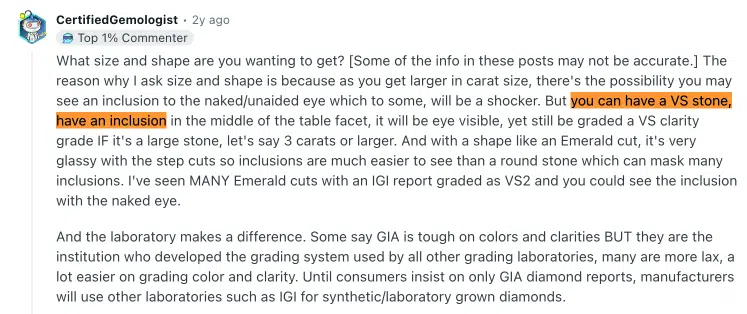
My Expert Verdict: This is 100% correct. When you’re inspecting diamonds in that 3-carat and up range, your level of scrutiny has to increase. For these magnificent, investment-grade stones, I often advise clients to make VS1 their starting point and to strongly consider a VVS2. It is a wise investment to ensure your magnificent centerpiece is flawlessly, undeniably clean from every angle.
The GIA Plot Map & 360° Video: Your Final Inspection
So, what do you do in these higher-risk scenarios? You don’t guess. You don’t hope. You become the expert. You use the tools that modern online jewelers have given you to make a final, authoritative call for yourself.
This is where your new knowledge of a GIA report becomes a superpower.
- Step 1: The GIA Plot Map. You find a stunning 2 carat VS1 clarity diamond on James Allen. The first thing you do is open its GIA report. You look at the “clarity plot”—that little map of the diamond’s internal fingerprint. You see that the GIA has marked a small “crystal” inclusion right under the main table.
- Step 2: The 360° Video. Now, you go to the 360° HD video. You spin the diamond. You zoom in. You hunt for that exact spot.
- Step 3: You Make the Call. You see the inclusion. Is it a tiny, transparent cloud that’s completely invisible in the brilliant sparkle? Or is it a dark crystal that catches your eye?
In five minutes, you have just done what only a master jeweler could do a decade ago. You have used the GIA’s map and the retailer’s technology to verify for yourself if the stone is truly “eye-clean.”
This is the power that savvy Reddit users talk about, like lovers_andfriends who confidently posted a picture of their GIA plot next to their SI1 diamond, effectively showing others how to perform their own verification.
This is the very essence of why companies like James Allen and Blue Nile, which we compare in our Vrai vs Blue Nile review, are so powerful. They don’t just sell you a diamond; they give you the tools to prove its beauty for yourself.
What a VS1 Grade Means for Your Finished Jewelry
Alright, we have spent a lot of time in the weeds, looking at loose diamonds under a virtual microscope. But at the end of the day, you’re not wearing a loose stone on your finger. You’re wearing a beautiful, finished piece of jewelry.
So, the final and most practical question is: what does that VS1 diamond grade mean when it’s part of a complete, finished ring that you’ll wear and cherish for a lifetime? Let’s zoom out from the lab report and talk about the jewelry itself.
The Anatomy of VS1 Engagement Rings
This is the term you’ll see most often online: a “VS1 engagement ring.” Let me be crystal clear about what this means. This term almost always refers to the quality of the center stone, the hero of the ring. The small accent stones on the band (the “melee” diamonds) are typically not individually certified.
A VS1 engagement ring is, therefore, the ultimate embodiment of the “sweet spot” strategy.
- The Look: It is a ring that is guaranteed to be visually flawless from a normal viewing distance.
- The Quality: The center stone has an exceptional, high-quality clarity grade backed by a GIA or IGI certificate.
- The Value: You get that perfect look for a price that is significantly less than the VVS or Flawless tiers.
Imagine a stunning 1.5 Carat Radiant Cut G/VS1 Ring from James Allen. This is a perfect example of a visually flawless, high-value vs1 ring.
The fiery, “crushed-ice” sparkle of the Radiant cut, which I cover in my Radiant Cut Diamond Secrets guide, masterfully hides the tiny VS1 inclusions, while the G color looks icy white. It is, in every sense of the word, a visually perfect masterpiece without the “perfection” price tag.
When you see retailers like Blue Nile or James Allen, whose craftsmanship I break down in my main James Allen Review, describe one of their vs1 engagement rings, you can be confident that you are looking at the savvy buyer’s choice for a beautiful and valuable “forever” piece.
James Allen is a top leader in online diamond sales, offering cutting-edge imaging technology that lets you inspect diamonds as if you were using a jeweler's loupe. With the largest exclusive selection of loose diamonds available online and excellent pricing, they also boast one of the finest collections of lab-created diamonds on the market. They currently run a 25% discount on selected lab-grown diamonds!
WHAT WE LOVE ABOUT THEM:
- 30-day no-questions-asked return policy, with a prepaid shipping label provided by James Allen.
- Lifetime warranty on all purchases.
- Free international shipping.
- Complimentary prong tightening, repolishing, rhodium plating, and cleaning every six months.
- Insurance appraisals included with purchases.
- One free resizing within 60 days of purchase.
- Free ring inscriptions available.
- Best-in-class high-quality imagery for every diamond in stock.
- 24/7 customer support.
- Premium, best-in-class packaging.
Is a “VS1 Diamond Chain” a Real Thing? A Jeweler’s Honest Answer
Now, let’s tackle a question I see all the time, and one that causes a lot of confusion. You’ll often see online sellers marketing a “VS1 Diamond Tennis Bracelet” or a “VS1 diamond chain.” Is this a real thing in the same way a GIA-certified VS1 is?
The brutally honest answer is: not really.
Let me explain.
- The Reality of “Melee” Diamonds: The dozens, or even hundreds, of tiny diamonds used in a tennis bracelet or chain are called “melee.” It is prohibitively expensive and logistically impossible to get an individual GIA certificate for every single one of these 0.01-carat stones.
- What “VS1” Actually Means Here: When a seller labels a chain as “VS1,” they are not guaranteeing that every single tiny diamond has been individually certified as a VS1. They are making a general claim about the parcel, or batch, of melee diamonds they used to create the piece. They are telling you that, on average, the diamonds used fall within the “VS” clarity range.
- The Trust Factor: Is this a legitimate claim? From a highly reputable brand, yes, you can generally trust they are using high-quality melee. From a random seller on Instagram? It is a massive gamble with no independent proof.
My Bottom Line: A VS1 clarity grade from the GIA is a powerful, verifiable fact for a single, significant diamond in the center of your vs1 ring. The term “VS1” when applied to a chain is a general, uncertified marketing description of its overall quality.
Understanding this distinction is a critical piece of insider knowledge that protects you, the buyer, and it’s a core reason that for a major purchase, you should always put your trust in a certified center stone, a philosophy we champion in our Best Places to Buy Engagement Rings Online guide.
FAQs About VS1 Diamond
Alright, we’ve gone deep. We’ve defined the terms, run the numbers, and laid out the expert strategy. But I know that when you’re this close to a decision, a flurry of very specific, very practical questions starts to bubble up.
This is the moment for straight talk. As your friend in the business, I’m going to answer the most common, and most important, questions I get about this “sweet spot” grade, with no fluff and no nonsense.
My Final Call: The Smartest Move on the Board
So, we come to the end of our deep dive. We’ve defined the terms, we’ve put the shocking prices side-by-side, we’ve learned the jeweler’s secret hacks, and we’ve navigated the expert-level exceptions.
After all of that, let’s go back to the original question: Is a VS1 clarity diamond good?
My final verdict, as your friend and GIA-trained expert in this business, is not just a “yes.” It’s an emphatic, table-pounding YES. A GIA-certified VS1 clarity diamond isn’t just a “good” choice; it is, for the vast majority of buyers, the single smartest move on the board.
It is the champion of the “visually perfect.” It’s the grade that gives you everything you can see (a flawlessly clean diamond) without charging you for anything you can’t (microscopic, on-paper purity). The question “is vs1 clarity good for your investment?” has a clear answer.
While no diamond is a financial investment in the traditional sense, a VS1 holds its relative value beautifully because it represents the perfect intersection of beauty, quality, and intelligence.
It is not a compromise. It is a strategic victory.
To make that final decision even simpler, here is my at-a-glance summary of this powerful sweet spot.
| Pros of a VS1 Diamond (The Wins) | Cons of a VS1 Diamond (The Trade-Offs) |
| Guaranteed to be 100% “eye-clean.” | Not “technically” a flawless stone. |
| Saves thousands vs. VVS grades. | Can have visible flaws in large step-cuts. |
| The ultimate “sweet spot” for value. | Requires a quick 360° video check. |
| Holds strong relative resale value. | Is not as rare as VVS grades on paper. |
Your Journey Continues: From “Sweet Spot” to “Perfect Ring”
Congratulations. You have just completed a masterclass in diamond clarity. You now hold the secret that separates savvy shoppers from everyone else. You know how to get a visually perfect diamond without needlessly overspending.
Your journey isn’t over, though. It’s just entering its most exciting phase. You’ve mastered clarity, and now it’s time to become an expert on every other facet of this incredible purchase. These are the hand-picked guides I’ve written to get you across that finish line with absolute, unshakeable confidence.
First, Put Your Newfound Knowledge to the Test
You are a clarity expert. Now, see how this knowledge gives you a massive advantage in my head-to-head showdowns of the industry’s biggest players.
- This is the main event. See how the king of experience stacks up against the ultimate value player in my definitive guide: The Unspoken Truth About Ritani vs James Allen.
- Learn how the modern online model fares against the traditional mall jeweler in my brutally honest breakdown: Zales vs Blue Nile: A Jeweler’s Unfiltered Comparison.
Next, Master the Art and Soul of the Diamond: Shape
You know what makes a diamond clean. Now it’s time to find the shape that captures your heart.
- For the lover of graceful, elegant curves that elongate the finger, you must read my definitive Pear-Shaped Diamond Ring Buying Guide.
- For a look that is truly unique and romantic, explore the symbolism and beauty of the Heart Shaped Diamond.
- And for the fashion-forward individualist who loves a bold, dramatic look, my deep dive on the Marquise Cut Diamond is essential reading.
Finally, Navigate the Practical, Real-World Steps of Your Journey
Let’s move from the diamond itself to the most important part of all: your life together.
- This is the ultimate question, and the answer is rarely simple. Let me give you my real, no-nonsense advice in my guide, How Much to Spend On a Wedding Ring.
- But is a big budget always necessary? My guide, Is $1000 a Lot for a Wedding Ring?, breaks down how to get incredible value.
- The timeline is crucial, and waiting too long is the #1 mistake couples make. My stress-free plan is here: When Do You Buy Wedding Rings?.

